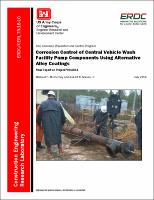Please use this identifier to cite or link to this item:
https://hdl.handle.net/11681/19826| Title: | Corrosion control of Central Vehicle Wash Facility pump components using alternative alloy coatings : final report on Project F09-AR14 |
| Authors: | Concurrent Technologies Corporation United States. Department of the Army. Office of the Assistant Chief of Staff for Installation Management DoD Corrosion Prevention and Control Program (U.S.) McInerney, Michael K. Mason, Robert B. |
| Keywords: | Corrosion and anti-corrosives Steel--Corrosion Metals--Cavitation erosion Metal coating Turbine pumps Fort Polk (La.) Central Vehicle Wash Facility Electroless nickel Thermal spray |
| Publisher: | Construction Engineering Research Laboratory (U.S.) Engineer Research and Development Center (U.S.) |
| Description: | Technical Report Abstract: Central Vehicle Wash Facilities (CVWFs) at military installations are essential for supporting the readiness of tactical vehicles. Steel wash-rack pumps are vulnerable to accelerated degradation where supply water is corrosive and infused with fines. Pump failure can occur with little warning, taking the CVWF out of service for unscheduled maintenance. This project tested two advanced coating materials on critical internal pump components to evaluate cost and performance. At the Fort Polk, LA, CVWF, internal components of one new pump were coated with a thermally sprayed cobalt alloy, and matching components in another pump were coated chemically with an electroless nickel (EN) material. Both pumps were used for 15 months, then disassembled and inspected. No significant corrosion degradation of pump components was observed on either pump. However, pump components coated using the EN process performed slightly better than those coated using the thermally sprayed alloy. The EN coating produced more uniform results and was less expensive, so it may be preferred by DPWs. The return on investment (ROI) for the EN coating is 2.59. Both coatings are conservatively estimated to double pump service life when compared with the previous pumps, but the lack of service records precluded a firm, data-driven prediction. |
| Rights: | Approved for public release; distribution is unlimited. |
| URI: | http://hdl.handle.net/11681/19826 |
| Appears in Collections: | Technical Report |
Files in This Item:
| File | Description | Size | Format | |
|---|---|---|---|---|
| ERDC-CERL-TR-16-10.pdf | 5.03 MB | Adobe PDF |  View/Open |